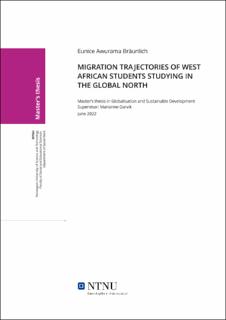| dc.description.abstract | This thesis explores the history of international student migration in the West African subregion and relates it to the current migration trajectories of international student migrants from the same subregion. This will form the basis for mapping and conceptualizing the patterns of such movements under the stepwise, serial, and circular theories of migration. To understand these patterns, this thesis delves into the factors that influence and or inhibit student migration from West Africa to the Global North. These include the factors that influence or constrain the decision to study abroad, the choice of destination countries and the choice of Higher Education Institution.This investigation will also be perpetuated through the lens of the aspirations-capabilities framework as propounded by De Haas.
Through a qualitative research approach, data was collected through interviews from student informants from Ghana, Nigeria, Senegal, Togo, Benin, Burkina Faso, and Côte D’ivoire who are currently spread across different locations in the Global North (GN). GN in this context includes countries in Europe, North America, and some parts of Asia. Using the diversity of their migration experiences, I identify stepwise and serial migration as the dominant migration patterns used among students from West Africa to access educational and professional opportunities in the Global North and circular migration as the least encountered in the sample group.
In this thesis, I also focus on the uncertainty of student migration experiences. This is because student migration is often associated with ‘safety’ as opposed to other forms of migration such as unskilled labor migration or forced migration due to conflict. The uncertainty in student migration is rooted in the multifaceted identity that embodies the term ‘international student’. International students are not merely persons pursuing higher education in other countries. They are simultaneously family members, citizens of particular countries, workers, and perhaps also refugees. (King & Raghuram, 2012, p. 134) They may be fathers, mothers, wives and husbands who may also responsible for the livelihoods of their families back home (King & Raghuram, 2012). It is this intersectionality of the identity of international students that makes their migration trajectories complex. This is because the identity they carry to each destination determines whether they thrive or struggle to meet their migration goal. It also determines whether they must stay, restrategize or give up on their quest of accessing better opportunities in the GN. Returning to the country of origin may in some instances, not be a viable option. In this paper, I emphasize on the coincidence of luck and opportunity in the acquisition of legal residence and job opportunities after higher education is completed. I also capture the accounts of former international students who have had to return to their home countries because of the absence of opportunities in the host country.
Lastly, the experiences of students are discussed along themes identified in my analysis of informant interviews. These themes are used to highlight the realities of living and studying in the Global North. More importhantly, the migration patterns that are used by students from West Africa to navigate these experiences, whether positive or negative are in focus in this thesis. I then conclude by proffering solutions to the challenges faced by this group of students as a way of making this form of migration safer and beneficial for all actors involved. | |
